Newton's Parakeet
| Newton's Parakeet | |
|---|---|
 | |
| Life drawing by Jossigny, 1770s | |
| Conservation status | |
| Scientific classification | |
| Kingdom: | Animalia |
| Phylum: | Chordata |
| Class: | Aves |
| Order: | Psittaciformes |
| Superfamily: | Psittacoidea |
| Family: | Psittaculidae |
| Subfamily: | Psittaculinae |
| Tribe: | Psittaculini |
| Genus: | Psittacula |
| Species: | P. exsul |
| Binomial name | |
| Psittacula exsul (Newton, 1872) | |
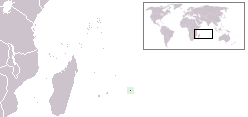 | |
| Former range | |
| Synonyms | |
| |
Newton's Parakeet or the Rodrigues Parakeet (Psittacula exsul) is an extinct species of parrot that was endemic to the Mascarene island of Rodrigues in the western Indian Ocean. The Alexandrine Parakeet of the same genus is a close relative and probable ancestor. Several of its features diverged from related species, indicating long-term isolation on Rodrigues and subsequent adaptation.
Around 40 centimetres (16 in) long, Newton's Parakeet was roughly the size of a Rose-ringed Parakeet. Its plumage was mostly greyish or slate blue in colour, which is unusual in Psittacula, a genus containing mostly green species. The male had stronger colours than the female and possessed a reddish instead of black beak, but details of a mature male's appearance are uncertain; only one male specimen is known, and it is believed to be immature. Mature males might have possessed red patches on the wing like the Alexandrine Parakeet. Both sexes had a black collar running from the chin to the nape, but this was clearer in the male. The legs were grey and the iris yellow. 17th-century accounts indicate that some members of the species were green, which would suggest that there were both blue and green colour morphs, but there is no definitive explanation for these reports. Little is known about its behaviour in life, but it may have fed on the nuts of the bois d’olive tree, along with leaves. It was very tame, and was able to mimic speech.
Newton's Parakeet was first written about by the French Huguenot François Leguat in 1708, and was only mentioned a few times by other writers afterwards. The specific name "exsul" is a reference to Leguat, who was exiled from France. Only two life drawings exist, both of a single specimen held in captivity in the 1770s. The first specimen known to science, a female, became the holotype when the species was described in 1872. A male was collected in 1874, and these two specimens are the only ones that exist today. It became scarce due to deforestation and perhaps hunting, but it is thought that it was finally wiped out by a series of cyclones and storms that hit Rodrigues in the late 19th century. There was unfounded speculation about the possible survival of the species as late as 1967.
Taxonomy
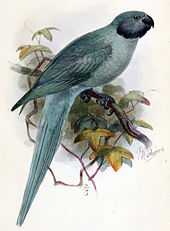
Newton's Parakeet was first recorded by François Leguat in his 1708 memoir, A New Voyage to the East Indies. Leguat was the leader of a group of nine French Huguenot refugees who colonised Rodrigues between 1691 and 1693 after they were marooned there.[2] Subsequent accounts are by Julien Tafforet, who was also marooned on the island in 1726, and then by the French mathematician Alexandre Pingré, who travelled to Rodrigues to view the 1761 transit of Venus.[3]
The first specimen known to science was a female collected by George Jenner, then the magistrate of Rodrigues, in 1871. The specimen was preserved in alcohol and given to Edward Newton, a colonial administrator in Mauritius, who sent it to his brother, the British ornithologist Alfred Newton. Alfred Newton scientifically described the bird in 1872 and gave it the scientific name Palaeornis exsul. "Exsul" ("exiled") refers to François Leguat, in that he was exiled from France when he gave the first description of the bird. Newton had tried to find a more descriptive name, perhaps based on colouration, but found it difficult. He refrained from publishing a figure of the female in his original description, though the journal Ibis had offered him the space. He instead wanted to wait until a male specimen could be procured, since he imagined it would be more attractive.[4] The female, which is the holotype specimen of the species, is housed in the Cambridge University Museum as specimen UMZC 18/Psi/67/h/I.[3]
Alfred Newton requested further specimens, especially males, but in 1875 he finally published a plate of the female, lamenting that no male specimens could be found. Tafforet's 1726 account had been rediscovered the previous year, and Alfred Newton noted that it confirmed his assumption that the male would turn out be much more colourful than the female. Newton's collector, Mr. Slater, had seen a live Newton's Parakeet the year before, but was not carrying a gun at the time.[5] On 14 August 1874, a Mr. Vandorous shot a male specimen. It was subsequently sent to Edward Newton by J. Caldwell.[6] This is the paratype of the species, numbered UMZC 18/Psi/67/h/2 and housed in the Cambridge Museum.[3]
Edward Newton noted that he had expected the male would be adorned with a red patch on the wing, but that the absence of this indicated it was immature. He still found it more beautiful than the female.[6] These two specimens are the only preserved individuals of the species.[7] The mandible and sternum were extracted from the female specimen, and subfossil remains have since been found in the Plaine Corail caverns on Rodrigues.[3] The genus Palaeornis was later declared a junior synonym of Psittacula, and all species within the former were transferred to the latter.[8]
Evolution
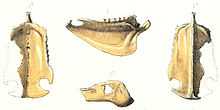
The Alexandrine Parakeet (Psittacula eupatria) has been proposed as the founder population for all Psittacula species on Indian Ocean islands during southward colonisation from its native South Asia. Features of that species gradually disappear in species further away from its range. Subfossil remains of Newton's Parakeet show that it differed from other Mascarene Psittacula species in some osteological features, but also had similarities, such as a reduced sternum, which suggests a close relationship. Skeletal features indicate an especially close relationship with the Alexandrine Parakeet, but the many derived features of Newton's Parakeet indicates it had long been isolated on Rodrigues.[3] The Rose-ringed Parakeet (Psittacula krameri) also appears to be closely related.[9]
Many endemic Mascarene birds, including the Dodo, are descended from South Asian ancestors, and the English palaeontologist Julian Hume has proposed that this may also be the case for all parrots there. Sea levels were lower during the Pleistocene, so it was possible for species to colonise some of these less isolated islands.[10] Although most extinct parrot species of the Mascarenes are poorly known, subfossil remains show that they shared common features such as enlarged heads and jaws, reduced pectoral bones, and robust leg bones. Hume has suggested that they have a common origin in the radiation of the Psittaculini tribe, members of which are known as Psittaculines, basing his theory on morphological features and the fact that Psittacula parrots have managed to colonise many isolated islands in the Indian Ocean.[3] The Psittaculini could have invaded the area several times, as many of the species were so specialised that they may have evolved significantly on hotspot islands before the Mascarenes emerged from the sea.[10] A 2011 genetic study of parrot phylogeny was unable to include Newton's Parakeet, as no viable DNA could be extracted. The same paper found that the Mascarene Parrot (Mascarinus mascarinus) of nearby Réunion was most closely related to the Lesser Vasa Parrot from Madagascar and nearby islands, and therefore unrelated to the Psittacula parrots, undermining the theory of their common origin.[11]
Description
_by_J.G._Keulemans.jpg)
Newton's Parakeet was about 40 cm (16 in) long - roughly the size of the Rose-ringed Parakeet.[10] The wing of the male specimen was 198 mm (7.7 in), the tail 206 mm (8.11 in), the culmen 25 mm (0.9 in), and the tarsus was 22 mm (0.8 in). The wing of the female specimen was 191 mm (7.5 in), the tail 210 mm (8.2 in), the culmen 24 mm (0.9 in), and the tarsus was 22 mm (0.8 in). The male specimen was greyish blue (also described as "slatey blue") tinged with green, and darker above. The head was bluer, with a dark line running from the eye to the cere. It had a broad black collar running from the chin to the nape, where it became gradually narrower. The underside of the tail was greyish, the upper beak was dark reddish brown, and the mandible was black. The legs were grey and the iris yellow. The female was similar, but had a greyer head and a black beak. The black collar was not so prominent as that of the male, and did not extend to the back of the neck.[12] The general appearance of Newton's Parakeet was similar to the extant Psittacula species, including the black collar, but the bluish grey colouration set it apart from other members of its genus, which are mostly green.[12]

Philibert Commerson received a live specimen on Mauritius in the 1770s and described it as "greyish blue". Jossigny made two illustrations of this specimen, the only known depictions of Newton's Parakeet in life, unpublished until 2007.[3] Though both existing specimens are blue, some early accounts from Rodrigues have caused confusion over the colouration of the plumage.[12] One of these is Leguat's following statement:
There are abundance of green and blew Parrets, they are of a midling and equal bigness; when they are young, their Flesh is as good as young Pigeons.[3]
If the green parrots Leguat referred to were not the Rodrigues Parrot (Necropsittacus rodericanus), they may perhaps have been a green colour morph of Newton's Parakeet, as Julian Hume has suggested. As Alfred Newton observed in his original description, some feathers of the female specimen display both blue and green tinges, depending on the light. This may explain some of the discrepancies.[3] The green parrots mentioned could also instead have been storm-blown members of Psittacula species from other islands, that survived on Rodrigues for a short time.[12] The two existing specimens were originally preserved in alcohol, but though this can discolour specimens, it is not probable that it could turn green to blue.[3]
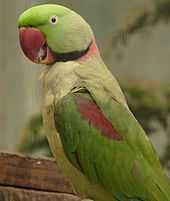
Julien Tafforet also described what appears to be green Newton's Parakeets in his 1726 Relation de l'Île Rodrigue, but the issue of colouration was further complicated:
The parrots are of three kinds, and in quantity ... The second species [mature male Newton's Parakeet?] is slightly smaller and more beautiful, because they have their plumage green like the preceding [Rodrigues Parrot], a little more blue, and above the wings a little red as well as their beak. The third species [Newton's Parakeet] is small and altogether green, and the beak black.[3]
It has been proposed that the last two types mentioned were male and female Newton's Parakeets, and that the differences between them were due to sexual dimorphism.[13] Alexandre Pingré also mentioned green birds, perhaps with some red colours, but his account is partially unintelligible and therefore ambiguous. A red shoulder patch is also present on the related Alexandrine Parakeet.[3] None of the existing Newton's Parakeet specimens have red patches. The single-known male specimen may have been immature, judged on the colour of its beak, and this may also explain the absence of the red patch.[12] When Psittacula are bred by aviculturalists, blue is easily produced from green; the production of blue may suppress red colouration, so blue morphs may have lacked the red patch.[3]
Behaviour and ecology

Almost nothing is known about the behaviour of Newton's Parakeet, but it is probable that it was similar to that of other members of its genus. Leguat mentioned that the parrots of the island mainly ate the nuts of the bois d’olive tree (Cassine orientale).[3] It may have fed on leaves as the related Mauritius Parakeet (Psittacula echo) does. The fact that Newton's Parakeet survived long after Rodrigues had been heavily deforested shows that its ecology was less vulnerable than that of, for example, the Rodrigues Parrot.[10]
Leguat and his men were hesitant to hunt the parrots because they were so tame and easy to catch.[9] Leguat's group took a parrot as a pet and were able to teach it to speak:
Hunting and Fishing were so easie to us, that it took away from the Pleasure. We often delighted ourselves in teaching the Parrots to speak, there being vast numbers of them. We carried one to Maurice Isle [Mauritius], which talk’d French and Flemish.[10]
As the kind of parrot mentioned here by Leguat is not specified, some sources attribute it to Newton's Parakeet, and others to the Rodrigues Parrot.[3][12]
Many other species endemic to Rodrigues became extinct after humans arrived, and the island's ecosystem remains heavily damaged. Forests covered the entire island before humans arrived, but very little forestation can be seen today. Newton's Parakeet lived alongside other recently extinct birds such as the Rodrigues Solitaire, the Rodrigues Parrot, the Rodrigues Rail, the Rodrigues Starling, the Rodrigues Owl, the Rodrigues Night Heron, and the Rodrigues Pigeon. Extinct reptiles include the domed Rodrigues giant tortoise, the saddle-backed Rodrigues giant tortoise, and the Rodrigues day gecko.[10]
Extinction
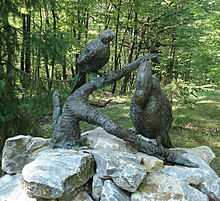
Of the roughly eight parrot species endemic to the Mascarenes, only the Mauritius Parakeet has survived. The others were likely all made extinct by a combination of excessive hunting and deforestation.[3] Leguat stated that Newton's Parakeet was abundant during his stay. It was still common when Tafforet visited in 1726, but when Alexandre Pingré mentioned it in 1761, he noted that the bird had become scarce. It was still present on southern islets off Rodrigues (Isle Gombrani), along with the Rodrigues Parrot. After this point, much of Rodrigues was severely deforested and used for livestock.[3] According to early accounts praising its flavour, it appears Newton's Parakeet was commonly eaten by visitors.[10] Several individuals would likely be needed to provide a single meal, owing to the bird's small size.[12] Pingré stated:
The perruche [Newton's Parakeet] seemed to me much more delicate [than the flying-fox]. I would not have missed any game from France if this one had been commoner in Rodrigues; but it begins to become rare. There are even fewer perroquets [Rodrigues Parrots], although there were once a big enough quantity according to François Leguat; indeed a little islet south of Rodrigues still retains the name Isle of Parrots [Isle Pierrot].[3]
According to government surveyor Thomas Corby, Newton's Parakeet may still have been fairly common in 1843. Henry H. Slater reported that he saw a single specimen in south western Rodrigues during his three-month stay to observe the 1874 Transit of Venus, and assistant colonial secretary William James Caldwell saw several specimens in 1875 during his own three-month visit. The male that he received in 1875 and gave to Newton is the last recorded member of the species. A series of cyclones struck the following year and may have devastated the remaining population.[3] Further severe storms hit in 1878 and 1886, and since few forested areas were left by this time, there was little cover to protect any remaining birds. The male could therefore have been the last of the species alive.[10]
There were unfounded rumours of its continued existence until the beginning of the 20th century.[10] In 1967 James Greenway stated that an extremely small population might still survive on small offshore islets, since this is often the last refuge of endangered birds.[14] Hume countered that these islets were probably too small to sustain a population.[3]
References
- ↑ BirdLife International (2012). "Psittacula exsul". IUCN Red List of Threatened Species. Version 2013.2. International Union for Conservation of Nature. Retrieved 26 November 2013.
- ↑ Leguat, F. (1891). Samuel Pasfield Oliver, ed. The voyage of François Leguat of Bresse, to Rodriguez, Mauritius, Java, and the Cape of Good Hope 2. London: Hakluyt Society.
- ↑ 3.0 3.1 3.2 3.3 3.4 3.5 3.6 3.7 3.8 3.9 3.10 3.11 3.12 3.13 3.14 3.15 3.16 3.17 3.18 3.19 Hume, J. P. (2007). "Reappraisal of the parrots (Aves: Psittacidae) from the Mascarene Islands, with comments on their ecology, morphology, and affinities". Zootaxa 1513: 4–29.
- ↑ Newton, A. (1872). "On an undescribed bird from the island of Rodriguez". Ibis 14: 31–34. doi:10.1111/j.1474-919X.1872.tb05858.x.
- ↑ Newton, A. (1875). "Note on Palaeornis exsul". Ibis 17 (3): 342–343. doi:10.1111/j.1474-919X.1875.tb05978.x.
- ↑ 6.0 6.1 Newton, E. (1876). "XXVII.-On the psittaci of the Mascarene Islands". Ibis 18 (3): 281–289. doi:10.1111/j.1474-919X.1876.tb06925.x.
- ↑ Rothschild, W. (1907). Extinct Birds. London: Hutchinson & Co. p. 65.
- ↑ Mayr, G. (2010). "Parrot interrelationships – morphology and the new molecular phylogenies". Emu 110 (4): 348. doi:10.1071/MU10035.
- ↑ 9.0 9.1 Hume, J. P.; Walters, M. (2012). Extinct Birds. London: A & C Black. pp. 175–176. ISBN 1-4081-5725-X.
- ↑ 10.0 10.1 10.2 10.3 10.4 10.5 10.6 10.7 10.8 Cheke, A. S.; Hume, J. P. (2008). Lost Land of the Dodo: an Ecological History of Mauritius, Réunion & Rodrigues. New Haven and London: T. & A. D. Poyser. pp. 46–56. ISBN 978-0-7136-6544-4.
- ↑ Kundu, S.; Jones, C. G.; Prys-Jones, R. P.; Groombridge, J. J. (2011). "The evolution of the Indian Ocean parrots (Psittaciformes): Extinction, adaptive radiation and eustacy". Molecular Phylogenetics and Evolution 62 (1): 296–305. doi:10.1016/j.ympev.2011.09.025. PMID 22019932.
- ↑ 12.0 12.1 12.2 12.3 12.4 12.5 12.6 Fuller, E. (2000). Extinct Birds. Oxford: Oxford University Press. pp. 225–227. ISBN 0-670-81787-2.
- ↑ Cheke, A. S. (1987). "An ecological history of the Mascarene Islands, with particular reference to extinctions and introductions of land vertebrates". In Diamond (ed.), A. W. Studies of Mascarene Island Birds. Cambridge. pp. 44–47. doi:10.1017/CBO9780511735769.003. ISBN 978-0521113311.
- ↑ Greenway, J. C. (1967). Extinct and Vanishing Birds of the World. New York: American Committee for International Wild Life Protection 13. pp. 107–108. ISBN 0-486-21869-4.
